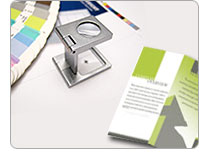- Products
-
Design Templates
- Featured Design Galleries
- More Galleries
- Services & Resources
- Free Sample Kit
- Deals
 How to fold your brochures is one of the most-asked and under-answered questions when it comes to graphic design. Often, this is an arbitrary decision and is not based on any actual marketing process; however, incorporating the fold type into your design can enhance the overall presentation of your message and help bring home the big sale. Here are a few pros and cons of different brochure folding options:
How to fold your brochures is one of the most-asked and under-answered questions when it comes to graphic design. Often, this is an arbitrary decision and is not based on any actual marketing process; however, incorporating the fold type into your design can enhance the overall presentation of your message and help bring home the big sale. Here are a few pros and cons of different brochure folding options:
Tried-and-true, the letter-fold brochure is a staple in many marketing campaigns. If corporate image is all about presentation, then the letter fold packs a punch. The brochure is folded into thirds with the right panel folded under the first panel. A letter-fold brochure is great for slowly revealing steps in a process and drawing the reader deeper into your pitch. Pull prospects in with a great offer on your front panel, demonstrate your features and benefits inside and deliver the call to action last. The only drawbacks to letter-fold brochures are that your front panel has to be perfect to get prospects to open them up, and that most other businesses routinely use them so your medium is identical, even if your design isn't.
Z-folds are perfect for big images and graphics, charts, graphs and even maps. This is because z-folds are folded in a z-shape (hence the name), so they unfold easily and naturally in the reader's hands. You can even use large text that forces the reader to open the brochure to see what it says. While z-fold brochures are big on impact, they're small on buildup. You basically have one shot to make your sale — but, that can be enough!
 Half-fold brochures open up a lot of creative possibilities. Some designers use them as small product guides because their added panel width allows for larger or more images without a fold slicing through them. They're great for product comparisons and images, and could even be used to emulate restaurant menus or display a golf course layout. Half-fold brochures are wider than the others, so they often grab attention and lend a certain level of professional credibility for being different — in a good way. Their width also means that they won't fit in brochure racks at hotels and welcome centers, however, so if your business needs tourist traffic you might want to consider another brochure folding technique. When given careful consideration, graphic designers can take advantage of different brochure folding styles when creating their clients' designs. Remember that you are not restricted to stay within panels, and that you can take advantage of the natural layout of any brochure to make your designs stand out — and attract more business for you. If you're going with professional brochure printing (and you should), make sure you get a template from your printer to make sure the brochure panels in your design match up to what the printed brochure will actually look like. PsPrint offers free templates for all these fold styles.
Half-fold brochures open up a lot of creative possibilities. Some designers use them as small product guides because their added panel width allows for larger or more images without a fold slicing through them. They're great for product comparisons and images, and could even be used to emulate restaurant menus or display a golf course layout. Half-fold brochures are wider than the others, so they often grab attention and lend a certain level of professional credibility for being different — in a good way. Their width also means that they won't fit in brochure racks at hotels and welcome centers, however, so if your business needs tourist traffic you might want to consider another brochure folding technique. When given careful consideration, graphic designers can take advantage of different brochure folding styles when creating their clients' designs. Remember that you are not restricted to stay within panels, and that you can take advantage of the natural layout of any brochure to make your designs stand out — and attract more business for you. If you're going with professional brochure printing (and you should), make sure you get a template from your printer to make sure the brochure panels in your design match up to what the printed brochure will actually look like. PsPrint offers free templates for all these fold styles.